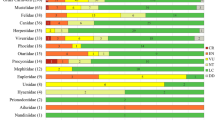Abstract
Ten sampling sites were selected to represent six distinct habitat types used by capybaras (‘clean’ lagoons, ‘dirty’ lagoons, cutwaters, fens and marshes, gallery forests, and erosion ditches). The sites were sampled during winter (July and August); densities were expressed as number of capybaras per linear km of shoreline (C/LKS). The sites were classified as protected from poachers (P), under light hunting pressure (LHP), and under heavy hunting pressure (HHP). ‘Clean’ protected (P) lagoons had three times as many capybaras as LHP ones (30.7 and 10.9 C/LKS, respectively), and thirty times those under HHP (1.0 C/LKS). Protected marshes and ‘dirty’ lagoons had even higher capybara densities (52.5 and 50.0 C/LKS, respectively). Gallery forests under LHP had low densities (6.3 C/LKS), and protected cutwaters intermediate densities (27.5 C/LKS). Erosion ditches had exceptionally high densities (900 C/LKS), probably because cattle were fenced out, reducing forage competition. These densities, when converted to the standard unit area measurement (individuals/ha), were similar to those obtained by other researchers in the Brazilian Pantanal, and somewhat smaller than those in the Venezuelan Llanos. Mean number of capybaras per group remained relatively constant in all habitats (averages ranged between 9.2 and 11.8 individuals/group) but its coefficient of variation was much higher in LHP sites, probably because social structure was altered severely by hunting. The overall ratio of young to adults and juveniles was 1:7.4. In one of the sites, 13 of 34 groups (38.2%) were with young (average of 17 capybaras per group, 4.7 of which were young), confirming that this species can reproduce all year long.
Similar content being viewed by others
References
Alho, C., Campos, Z. and Gonçcalves, H. 1987. Ecología de capivara (Hydrochaeris hydrochaeris, Rodentia) do Pantanal: I — Habitats, densidades e tamanho de grupo. Rev. Brasil. Biol. 47(1/2): 87–97.
Bruniard, E. 1966. Bases fisiográficas para una división regional de la Provincia de Corrientes. Nordeste 8: 7–80.
Cabrera, A. 1971. Fitogeografía de la República Argentina. Bol. Soc. Arg. Bot. XIV (1–2): 1–42.
Cordero, G. and Ojasti, J. 1981. Comparison of capybara populations of open and forested habitats. J. Wildlife Man. 45(1): 267–271.
Daniel, W.W. 1978. Applied non-parametric statistics. Houghton Mifflin Co., Boston. 503 pp.
De Azcárate, T. 1981. Sociobiologá y manejo del chiguire. Doñana Acta Vertebrata 7: 1–228.
Escobar, A. and González Jiménez, E. 1976. Estudio de la competencia alimenticia de los herbívoros mayores del Llano inundable, con referencia especial al chigüire (Hydrochaeris hydrochaeris). Agron. Trop. XXVI(3): 215–227.
F.A.A. (Fuerza Aérea Argentina). 1972. Estadísticas climatológicas, 1951–1960. Serie B, No. 6: 156 pp.
Herrera, E. 1985. Coprophagy in the capybara, Hydrochoerus hydrochaeris. J. Zool. (London): 616–619.
Herrera, E.1986. Vida en grupos y ecología del capibara. Resúmenes del Congreso Latinoamericano de Zoología (Viña del Mar, Chile). P. 269.
Herrera, E. and Macdonald, D. 1987. Group stability and the structure of capybara populations. In: Harris, S. (ed.), Population studies of mammals, pp. 115–130. Symposium of the Zoological Society of London, Vol. 58. London.
Herrera, E. and Macdonald, D. 1989. Resource utilization and territoriality in group-living capybaras (Hydrochoerus hydrochaeris). J. An. Ecol. 58: 667–679.
Jorgeson, J. 1986. Notes on the ecology and behaviour of capybaras in Northeastern Columbia. Vida Silvestre Neotropical 1: 31–40.
Lewontin, R.C. and Levins, R. 1989. On the characterization of density and resource availability. Am. Nat. 134: 513–524.
Macdonald, D. 1981. Dwindling resources and the social behaviour of capybaras (Hydrochoerus hydrochaeris)(Mammalia). J. Zool. (London) 194: 371–391.
McNaughton, S. 1984. Animals in herds, plant form and coevolution. Am. Nat. 124: 863–886.
Ojasti, J. 1973. Estudio biológico del chigüire o capibara. Fondo Nacional de Investigaciones Agropecuarias (FONAIAP), Caracas. 275 pp.
Ojasti, J. and Sosa Burgos, L. 1985. Density regulation in populations of capybara. Acta Zool. Fennica 173: 81–83.
Quintana, R. 1989. Informe sobre las actividades realizadas en la República de Venezuela entre 9/1/89 y el 21/3/89 en el marco del convenio CONICET (Argentina) y CONICIT (Venezuela): ‘Intercambio Científico-Técnico sobre Aprovechamiento de la especie Carpincho (Hydrochaeris hydrochaeris)’. 61 pp.
Schaller, G. and Crawshaw, P. 1981. Social Dynamics of capybara population. Saugetierkundliche Mitteilungen 29: 3–16.
Author information
Authors and Affiliations
Additional information
Requests for reprints should be sent to: Dr. J. Rabinovich.
Rights and permissions
About this article
Cite this article
Quintana, R.D., Rabinovich, J.E. Assessment of capybara (Hydrochoerus hydrochaeris) populations in the wetlands of Corrientes, Argentina. Wetlands Ecol Manage 2, 223–230 (1993). https://doi.org/10.1007/BF00188156
Issue Date:
DOI: https://doi.org/10.1007/BF00188156




